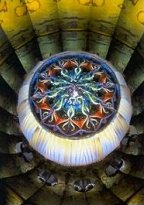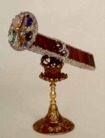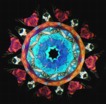
kaleidoscope - A cylindrical optical instrument that is rotated so that when a person looks into it, the viewer sees a succession of radial designs produced by a carefully arranged set of mirrors reflecting constantly changing patterns made by small translucent objects (often bits of colored glass such as millefiori) in a chamber at one end of the cylinder. The first kaleidoscope was invented by David Brewster (Scottish, 1781-1868) in 1816. One type of kaleidoscope, known particularly as a teleidoscope, displays mirrored images of whatever portion of a person's environment can be seen through the opening in the other end of the scope. "Kaleidoscope" can also refer to a constantly changing set of colors, or a series of changing phases or events. The word comes from Greek words meaning "a view of beautiful form."
Examples:

Charles G. Bush (1825-1900, American, born
Germany) designer, C.G. Bush & Co. manufacturer, Providence,
Rhode Island, Table Parlor Kaleidoscope, c. 1870s, black cloth over cardboard, brass mounted, mahogany stand, height 14 inches. The cardboard tubular
barrel is covered with black pebbled stamped paper, with cylindrical eye piece at one end, and with
brass-mounted chamber box on the other end turned by hand with
6-brass spokes. The chamber box contains multi-colored glass twists and rods, cuts of German
sheet glass in various forms, and his liquid-filled ampules,
patented in 1873 -- all of which are exposed to light through the 3-inch lens, revealing various changing geometric patterns. The scope is canted at a downward angle on a turned mahogany stand with
central baluster standard and flared dish base.
![]()

English or American?, Kaleidoscope's
View, 19th
century.

A view in one 20th century kaleidoscope.


Marc and Susan Lundgren-Tickle (Americans,
contemporary), Eye of the Soul, 2000, in an edition limited
to 30, glass exterior hand-painted in reverse. This scope has
two eye openings through which to view what at first appears
to be one image. One opening displays a view from the top down;
the other from the side. It employs a liquid object chamber,
and displays a 10-point mandala on top of a "dichroic sphere."
An image from Eye of the Soul. See
sphere.

Cindy Vellinga (Canadian, contemporary),
Kaleidoscope and Stand, c. 2001, stained glass, millefiori, mirrors, solder, and a brass stand.

Barbara (American, contemporary), Butterfly Brass Tube, c. 2002, wheels hold actual butterfly and moth
wings, a wooden stand, kaleidoscope: 8 x 3 inches.
"All species used are 'naturally expired.'"

![]()
Janice Chesnik (American, contemporary),
SuperNova, c.2003, brass, two-mirrored kaleidoscope lying on a pillow.
A view
in this kaleidoscope.
Also see lens, mandala, projection, and slide.
https://inform.quest/_art